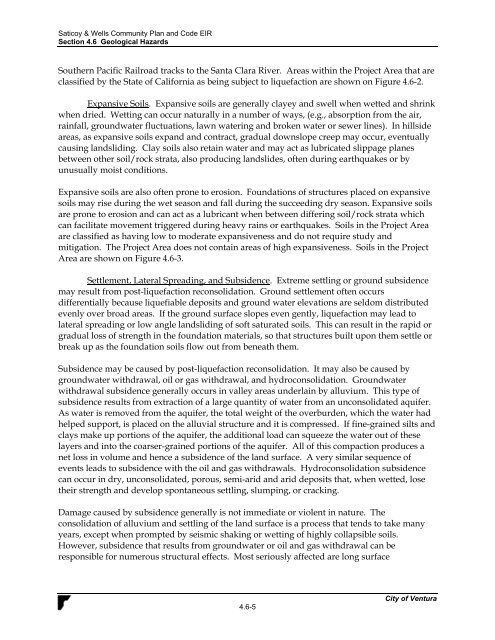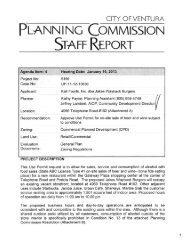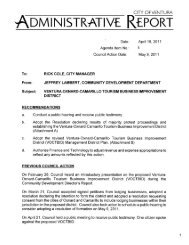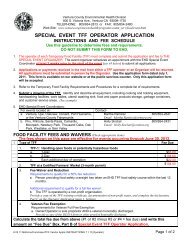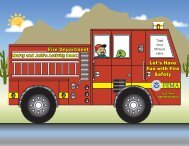Saticoy & Wells Community Plan & Development ... - City Of Ventura
Saticoy & Wells Community Plan & Development ... - City Of Ventura
Saticoy & Wells Community Plan & Development ... - City Of Ventura
Create successful ePaper yourself
Turn your PDF publications into a flip-book with our unique Google optimized e-Paper software.
<strong>Saticoy</strong> & <strong>Wells</strong> <strong>Community</strong> <strong>Plan</strong> and Code EIRSection 4.6 Geological HazardsSouthern Pacific Railroad tracks to the Santa Clara River. Areas within the Project Area that areclassified by the State of California as being subject to liquefaction are shown on Figure 4.6-2.Expansive Soils. Expansive soils are generally clayey and swell when wetted and shrinkwhen dried. Wetting can occur naturally in a number of ways, (e.g., absorption from the air,rainfall, groundwater fluctuations, lawn watering and broken water or sewer lines). In hillsideareas, as expansive soils expand and contract, gradual downslope creep may occur, eventuallycausing landsliding. Clay soils also retain water and may act as lubricated slippage planesbetween other soil/rock strata, also producing landslides, often during earthquakes or byunusually moist conditions.Expansive soils are also often prone to erosion. Foundations of structures placed on expansivesoils may rise during the wet season and fall during the succeeding dry season. Expansive soilsare prone to erosion and can act as a lubricant when between differing soil/rock strata whichcan facilitate movement triggered during heavy rains or earthquakes. Soils in the Project Areaare classified as having low to moderate expansiveness and do not require study andmitigation. The Project Area does not contain areas of high expansiveness. Soils in the ProjectArea are shown on Figure 4.6-3.Settlement, Lateral Spreading, and Subsidence. Extreme settling or ground subsidencemay result from post-liquefaction reconsolidation. Ground settlement often occursdifferentially because liquefiable deposits and ground water elevations are seldom distributedevenly over broad areas. If the ground surface slopes even gently, liquefaction may lead tolateral spreading or low angle landsliding of soft saturated soils. This can result in the rapid orgradual loss of strength in the foundation materials, so that structures built upon them settle orbreak up as the foundation soils flow out from beneath them.Subsidence may be caused by post-liquefaction reconsolidation. It may also be caused bygroundwater withdrawal, oil or gas withdrawal, and hydroconsolidation. Groundwaterwithdrawal subsidence generally occurs in valley areas underlain by alluvium. This type ofsubsidence results from extraction of a large quantity of water from an unconsolidated aquifer.As water is removed from the aquifer, the total weight of the overburden, which the water hadhelped support, is placed on the alluvial structure and it is compressed. If fine-grained silts andclays make up portions of the aquifer, the additional load can squeeze the water out of theselayers and into the coarser-grained portions of the aquifer. All of this compaction produces anet loss in volume and hence a subsidence of the land surface. A very similar sequence ofevents leads to subsidence with the oil and gas withdrawals. Hydroconsolidation subsidencecan occur in dry, unconsolidated, porous, semi-arid and arid deposits that, when wetted, losetheir strength and develop spontaneous settling, slumping, or cracking.Damage caused by subsidence generally is not immediate or violent in nature. Theconsolidation of alluvium and settling of the land surface is a process that tends to take manyyears, except when prompted by seismic shaking or wetting of highly collapsible soils.However, subsidence that results from groundwater or oil and gas withdrawal can beresponsible for numerous structural effects. Most seriously affected are long surface4.6-5<strong>City</strong> of <strong>Ventura</strong>


